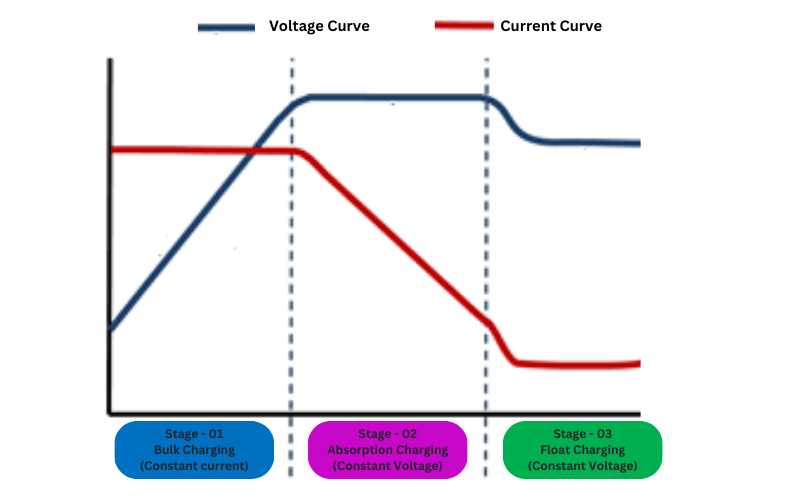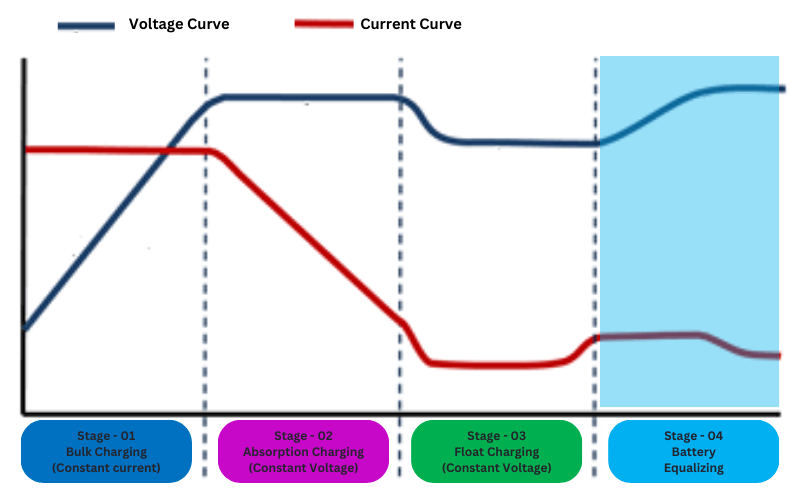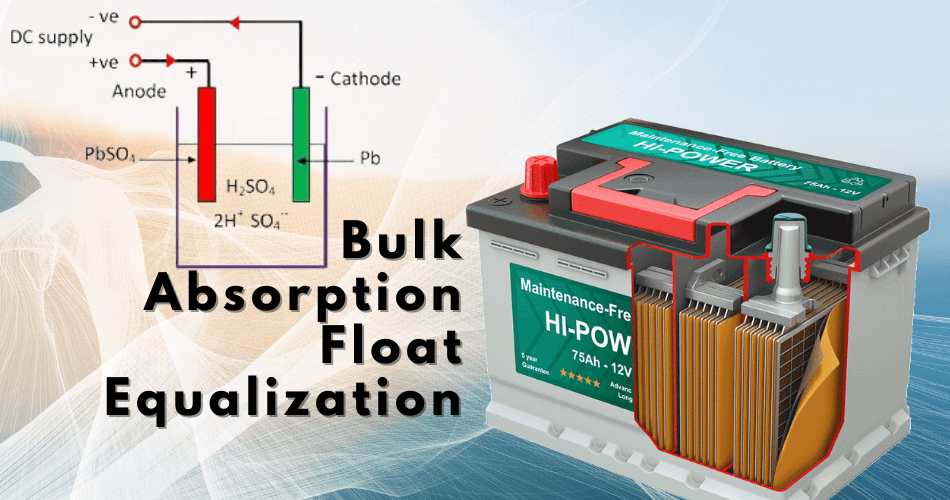So, you own an off-grid system that operates on lead-acid batteries, and you would like to understand a bit more about what it means by those charging stages: the bulk, absorption, float, and equalization.
Have you ever had any questions like, what kind of voltages should I see? When is my battery full? When do I need to equalize, and possibly, what could I do to improve the performance of my system and extend the lifetime of my off-grid lead acid battery system?
In this guide, we are going to answer all those questions, specially focusing on lead acid Batteries. So this includes the flooded and the valve-regulated lead acid batteries, including the AGM and GEL batteries.
I will explain what is happening during the different charging and discharging stages of your Lead Acid battery, and by the end, you will understand what is supposed to happen and what to look out for in your battery bank.
Table of Contents
What is actually happening in a Lead Acid battery?
A battery takes energy in the form of electricity and stores it into chemical energy. But keep in mind that this conversion ratio is not 100% efficient. It’s always a little bit less due to losses and internal resistance.
A Lead-Acid battery consists of two primary components: lead dioxide (PbO2) as the positive plate and sponge lead (Pb) as the negative plate. Both od those electrodes are submerged in an electrolyte solution of sulfuric acid (H2SO4).
When the battery discharges, the lead dioxide (positive plate) and the sponge lead (negative plate) react with the sulfuric acid electrolyte, producing lead sulfate (PbSO4) and water (H2O). This reaction releases electrons through the external circuit, providing electrical power.
Then the sulfuric acid concentration decreases, and water concentration increases, which lowers the battery’s voltage. That`s what we call as battery discharge.
Charging the battery reverses the discharge chemical reactions. There, we apply an external electrical current to convert the lead sulfate and water back into lead dioxide, sponge lead, and sulfuric acid.
What are the Three Main Stages of Charging a Lead Acid Battery?
Bulk, Absorption, and Float are the 3 main charging stages of a typical lead acid battery. In addition, there could be one more stage called equalizing charge.

Bulk Charging Stage
So, the first charging stage is bulk, in which the battery is typically less than 80% charged. In this stage we generally allow as much power to flow into the battery, adhering to two different conditions.
The first one is that the amount of electricity flowing into the battery (Amperage) should typically not exceed 20% of the total amp-hour rating of the battery. But this condition may depend on the battery type. For example, some Lead-acid batteries, like Solar Tubular, can accept high charging currents in bulk stage.
The second condition is regarding the endpoint of the bulk stage. When we push energy into the battery, the battery voltage will be increased. So, we need to stop the voltage level beyond a certain level, and this level is described as the absorption voltage. We need to set that specific voltage level in our charger device. So that brings us to the next stage: Absorption.
Absorption Charging Stage
As a result of the bulk charging, the voltage in the battery has reached the absorption voltage or the absorption pressure. So now your charging device will switch its behavior into absorption charging mode.
Throughout this stage, the charge controller will maintain a constant charging voltage and a reducing current with time. We can define the end of the absorption stage in two ways, either by time or current rating.
When a certain time frame has been set for the absorption charging time, the controller will end this stage after that time. For example, two or three hours of time.
Or secondly, it can end the absorption after the current rating drops below a certain preset value. (We already mentioned that the Amp rating would go down by the time). At this point, you’ve reached the float stage, in which your battery is as fully charged as it can possibly be.
Now, I’m intentionally saying that the battery is as full as it can possibly be because it doesn’t mean that your battery now has the capacity that it had when it was new. It just means that you have charged it as fully as you can under the current conditions.
Float Charging Stage
Float charging is a battery charging stage where the voltage is reduced and maintained at a lower level to keep the battery fully charged over a long period without overcharging it. This stage follows the bulk and absorption stages in a typical charging cycle.
The primary purpose of float charging is to maintain the battery at 100% charge without causing overcharges, which can damage the battery. It’s especially important for batteries that are used in standby or backup power systems, where they must be kept fully charged and ready for immediate use.
During the float charging stage, the voltage is typically set around 2.25 to 2.27 volts per cell, which amounts to about 13.5 to 13.8 volts for a 12-volt battery. This voltage level is sufficient to counteract self-discharge, keeping the battery topped up without causing excess gassing or water loss.
For the specific float voltage for your battery, I’m going to say the same as for the absorption voltage. Download the specification sheet and check. It really depends on which battery you have, but typically, it is between 13 to 14 volts.
Normally, it`s good to reach the float stage every day. The less ideal will be every four to five days. Less than that means you would probably be affecting the lifetime of your battery.
Does Temperature Affect to Charge Cycle of Lead-acid Batteries?
Yes, temperature could affect the charging and discharging cycles of the lead acid batteries. Mainly, it could change the respective charging voltage levels for different charging cycles.
The best part of modern charge controllers is that they can adjust these voltage values automatically depending on the temperature fluctuations.
The tricky thing is that if you’ve got your charge controller and batteries mounted in separate locations, your batteries can become hot without signaling to the charge controller. So, how do you fix or improve this? Either way you can install your charge controller in the same temperature zone as your battery, or if your charge controller allows for it, you can connect a hardwired or a wireless temperature sensing device between your charge controller and the batteries itself.
Battery Equalization
As we mentioned in the beginning, the charging and discharging are not 100% perfect, and because of that, you may not manage to get your batteries into float. Now, there is a quick and dirty solution for this, which is called as Equalization.
During equalization, the battery voltage will be raised to a very high level for a limited time. Then, air bubbles will be formed on the two electrode plates. These bubbles will blow off any kind of hard sulfur particles that might have formed on the plates themselves. Also, these bubbles will mix up the electrolyte in your battery and distribute it evenly.

Now, you may think that these bubbles will not only blow off the sulfur particles but also some of the actual lead on your plates. So, they will just fall off and go to the bottom of your battery. It can never be recovered and reduces the overall capacity and lifetime of your battery.
Which types of Batteries need to be Equalized?
Now, as we discussed, the bubbles could normally mix up the liquid electrolyte in your battery. So, Battery equalization can be done in flooded lead acid batteries. But if you have a different kind of electrolyte, like in AGM or Gel, this doesn’t work really well.
Typically, AGM and GEL batteries are not required and are not allowed to be equalized.
Conclusion
Okay, so I hope this guide gave you a basic understanding of what’s happening during the different charging stages in your battery. Read our ultimate buying guide to compare and contrast lead acid batteries with other types of Off-grid batteries.
